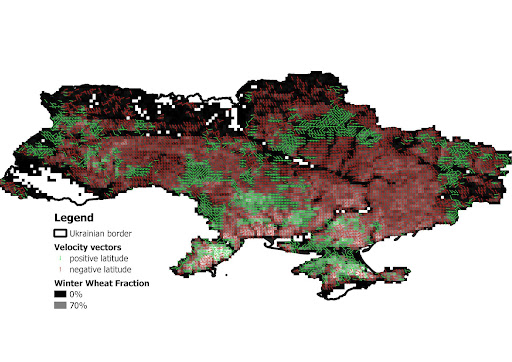GEOG PhD student Leonid Shumilo and GEOG and iSchool Assistant Professor Sergii Skakun have been awarded a Future Investigators in NASA Earth and Space Science and Technology (FINESST) grant for their project “Agriculture Velocity of Winter Wheat.” The FINESST program, aimed at training future leaders in Earth and Space Science, funds graduate students to develop and perform research aligned with the goals of NASA’s Science Mission Directorate.
Shumilo’s project introduces the concept of agriculture velocity, which measures how cropland extents change through space and time. The project will estimate winter wheat velocity for 11 major wheat producing countries and address the following research questions:
- What is the magnitude of winter wheat agriculture velocity in major wheat producing countries in the past 20 years?
- What are the relationships between agricultural velocity and climate change?
- What are the future projections of winter wheat cropland extent with regard to agriculture velocity and climate change scenarios projections?
Results of this study will provide information on the trends of global wheat production and a novel instrument for climate change impact evaluation on agriculture. The unique output of this study will be a collection of agriculture velocity maps that will reflect the spatial dynamics of cropland extent changes and can be used for further food production forecasting models.
Shumilo, who studied applied mathematics, machine learning, and Earth observation-based agriculture monitoring at Kyiv Polytechnic Institute in Ukraine, developed the concept of agriculture velocity in his first year as a PhD student at UMD. “When Professor Hurtt was presenting us the concept of climate velocity and response of biology, I said to myself–this is what I used to see in crop maps I generated for Ukraine. Agriculture responds to climate in the same way as trees or animal species–through migration,” he said. Shumilo further investigated methodologies from Hurtt's biogeography course as well as ideas from GEOG Associate Professor Meredith Gore’s Coupled Human and Natural Systems course as he refined his concept of agriculture velocity, which would ultimately form the basis for his thesis and FINESST proposal. “My biogeography class project grew into an interesting research project supported by NASA,” said Shumilo.
Congratulations, Leonid!

Figure 1. Optical flow-based vector field of agriculture velocity. Green arrows show the flow of winter wheat to the lower longitude and means positive gradient of winter wheat fraction change in southern direction, red arrows show the flow of winter wheat to the higher longitude and means positive gradient of winter wheat fraction change in north direction


